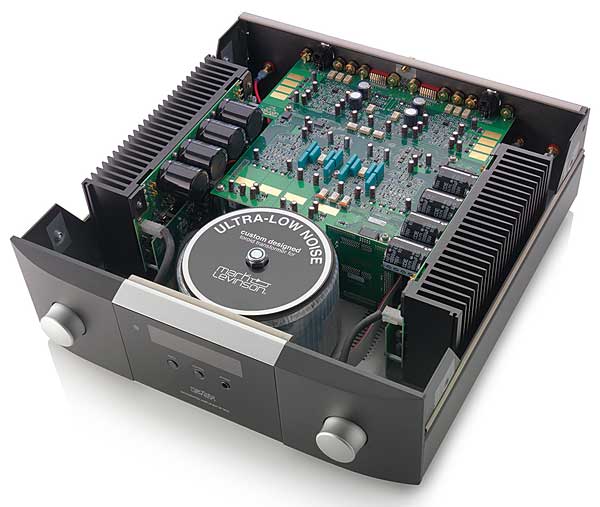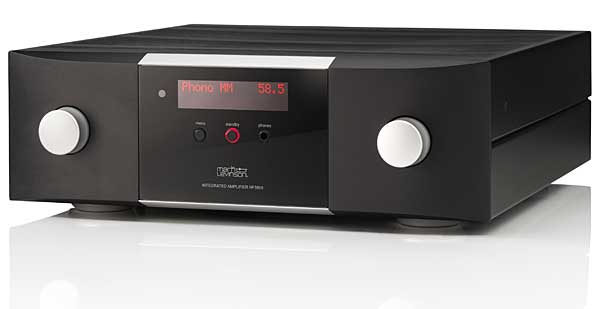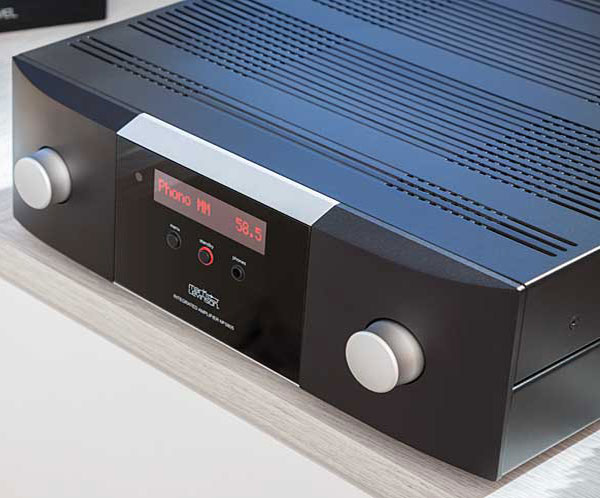| Columns Retired Columns & Blogs |
So, how does the sound compare to the 585? One can now occasionally find a used 585 for a similar price.
I love the way Nojima sounds, but, with apologies to Dr. J, John's recording sounds more natural—more like a Steinway sounds from really good seats in a smallish hall. And Silverman's interpretation is faultless.
With my reference electronics in place, I put on the "Andante Sostenuto-Quasi Adagio" from the B-minor sonata and turned up the volume until I heard what sounded like concert-hall levels; the ffs (and fffs) between approximately 3 and 4 minutes into the piece were satisfying but not strained. I checked the volume with pink noise and a level-meter app on my iPhone. The level was right at 75dB, peaking at 75.8. Then I moved the speaker cables over to the Levinson, played the same pink-noise track, and, using the volume control on the Levinson, matched the volume within 0.1dB (75.7dB). I repeated the second movement from the Liszt B-minor sonata.

In the hall evoked by the Levinson, I found myself closer to the piano. The aural image was bigger, higher, and ever so slightly less specific. The leading edges of notes were a shade less percussive. I did not perceive the music as louder through the Levinson—and it wasn't louder—but, except for actual perceived volume, the effect was typical of what I hear when I turn the volume up. It was perhaps slightly more vivid—more impressive—but also marginally less live-sounding; the illusion of a piano rooted to the floor of the stage in a concert hall was marginally less convincing. But the musical impact was not diminished. I preferred my $30,000 chain of components, but other people might prefer the bigger, slightly more forward presentation from the $8500 Levinson box. I played around a bit with filter settings and turned oversampling on and off. None of that altered the Levinson's basic sonic character. If I didn't earn my living by rooting out distinctions among components, I could live with this sound quite happily.
Which part of the No.5805 is responsible for the differences I heard, relative to the reference system? Was it the DAC? The amp? The preamp? As it turns out, all of the above.
I ran the output from my PS Audio DAC into the Levinson's balanced analog input. The sound was louder by several dB, so I wrote down the Levinson's volume setting and then turned the volume down using the remote. I was now directly comparing the Levinson DAC to the PS Audio DAC, through the Levinson's amp and preamp. Now the sound was more like that of my reference system, but the images were still bigger and closer—all the symptoms of being louder without actually being louder (footnote 4).
Perhaps a good visual comparison would be with one of Monet's big water lily canvasses—a little more colorful than life, slightly less resolved than a truly realistic image, but beautiful. (This analogy, while qualitatively sound, greatly exaggerates the differences.)
Groovin'
I turned to the phono stage. I had no MM cartridges on hand, so I listened to my low-output Ortofon Xpression MC in my usual manner, by boosting its output with the Ortofon-specific version of the standard Auditorium 23 step-up transformer (SUT), itself driving my EAR 834P phono preamp, set to MM mode. (That classic, 20-year-old phono pre will soon be retired (footnote 5). This, finally, is almost a fair comparison: The current price of the Auditorium 23 is $1395—and that, combined with the $1895 price of the EAR, puts my phono-amplification setup at least in the same ballpark as a reasonable valuation of the phono section of the Levinson No.5805.

I rematched levels again, this time using a pink noise track from a test LP. I put on a couple of familiar records, but mainly I listened to my OJC pressing of Mulligan Meets Monk (OJC-301, from the original Riverside, RLP-1106), an album I've played hundreds of times. It's a good test record because the rhythm section (Wilber Ware and Shadow Wilson) is a bit soft on many tracks and can be hard to resolve behind the much louder horn and piano. On a good system, they're positioned precisely, a bit further behind the headliners than you'd see and hear at a show—10 feet, maybe?
Used with the Auditorium 23 step-up transformer, both stages proved colorful and engaging. The Levinson had slightly better low-end extension and bass definition. I heard no loss of color or texture—but then I usually don't, as long as the step-up transformer is in the mix. Overall, the Levinson stage bettered the EAR, but it was close; the differences I heard were in a range easily masked by small volume misadjustments.
An active MC phono stage is a harder thing to pull off than a comparable MM, especially if it's to work with low-output MCs. The challenge is surely exacerbated when you must stick it inside the same box as a power amplifier, a sophisticated and possibly noisy control computer, and a DAC that switches at high speeds. All those things are present in the Levinson.
Let's remove the SUT and see how the Levinson fares in MC mode.

At first, I had some noise issues, but they turned out to be my fault entirely: My grounding was a mess. When I simply connected the ground wire from my Schick 12" tonearm directly to the Levinson's phono ground, the noise went away.
A little broad-spectrum noise remained in the background, the kind you can only hear if you turn the volume up loud, lift the needle, and stick your ear to the loudspeaker. With a record on, this kind of noise is masked by groove noise, which is similar in character, even on very quiet records. When the music starts, there's no chance of hearing it—and even if you could, wideband noise is unobjectionable.
Once I got things tuned, the sound was great. On Monk's own "Rhythm-a-ning"—one of the tracks with a more prominent rhythm section—soundstage depth was excellent, with Ware and Wilson eight or so feet back from the Monk-Mulligan plane. Every note of Ware's bass had easily identifiable pitch—not the case on every vinyl system. Monk's piano was suitably percussive. Wilson's cymbals had energy but weren't harsh. This recording, which I know very well, sounded like itself.
I encountered a small operational issue with the No.5805: Switching from one input to another could take a second or more. Todd Eichenbaum, Harman's director of engineering for luxury audio, told me that such slow switching is necessary because of the Levinson's direct-coupled design. "We need to allow extra time when changing inputs because the unit is direct coupled and DC needs time to settle. Speeding this up would result in pops when changing inputs. . . . [W]e've been tweaking software and our order of operations when changing inputs, and later software should be able to speed this up a bit." This is another one of those how-much-does-it-matter issues. I found it annoying when trying to compare one input to another—the internal DAC to an external DAC, for example—but this matters far less when what you want to do is just listen to music.
Headphones
I listened briefly through the No.5805's to my Sennheiser HD 650s. There's not enough space to do a proper report, but I can say this much: The Levinson's headphone output was free of audible noise, drove the HD 650s to high-enough volumes, and revealed what I've come to think of as the HD 650's basic character: resolving—though perhaps not as resolving as today's best headphones—with a voicing that's slightly south of neutral.
Conclusions
I was fledged in the 1980s on $300 Japanese receivers. I've since been exposed to some pricey hi-fi, but I haven't been indoctrinated to the point where I'm inured to audio's high prices. $8500 is modest by perfectionist hi-fi standards—especially when you consider how much utility it buys. But it's still a lot of money, for just about everyone. That said, the Levinson No.5805 is cheaper than just about everything else in its class.
Compactness matters, too: My amps, preamp, DAC, and phono stages together approach something like five times the Levinson's mass, and three to four times its volume. A lot of shelf (and floor) space is liberated by putting it all in one box.
Perfectionist audio is an odd pursuit. I spend approximately three-quarters of my time pursuing it, and the other quarter wondering if it's worth it. How much sense does it make to spend so much time and money in pursuit of live-caliber sound from a domestic playback system when it's only approachable with a relative handful of the very best recordings? I'm not planning to, but if I were to decide tomorrow to leave the world of high-end audio and settle down, say, in a small cottage in the Florida Keys with a dog, a dock, and a flats boat out back, I'd very seriously consider a product such as this: The No.5805 offers excellent sound in an attractive, versatile package. There's little or nothing to fault.
Footnote 4: Perhaps, then, I could just turn the volume down and reverse the effect? I tried it. The size of the piano shrank a little and the image gained a little focus, but transients continued to seem a little bit less sharp, and now the music seemed quieter. All of which presents an idea I hadn't thought of before: I've long been a believer that there's an optimal volume setting for every recording of acoustic music—but does that setting depend on the converter used?
Footnote 5: Which, after 20+ years of good reputation, is being replaced in the EAR lineup. In the coming months, I'll be reviewing its replacement.
Footnote 6: There are many other ways to appreciate perfectionist sound, but none is quite so satisfying as a recorded performer suddenly appearing in your listening room.

So, how does the sound compare to the 585? One can now occasionally find a used 585 for a similar price.

If you already have or, in the market for under $5,000 speakers, Outlaw Audio RR2160, which was reviewed by Stereophile may be a good choice :-) ...........

"That said, the Levinson No.5805 is cheaper than just about everything else in its class."
Really? The NAD M32, at half the price, offers more power, a DAC with higher resolution (20 bits versus 18) and lots of functionality. I'd choose the NAD (I did).

... measured continuous power output as the M-L No.5805, plus it includes streaming capability and a room correction function - all for only $750.
https://usa.yamaha.com/products/audio_visual/hifi_components/r-n803/index.html
https://www.eisa.eu/awards/yamaha-r-n803d/
https://audio.com.pl/testy/stereo/amplitunery-stereo/2984-yamaha-r-n803d
The amplifier/DAC section is similar to that of the A-S801 integrated amp about which a TAS reviewer said:
"The Yamaha A-S801 looks good, sounds splendid, and has a long list of useful features at a price that makes it a flaming bargain! I suspect many readers are lifelong audiophiles like me, for whom system upgrades are a way of life, possibly even the purpose of life. But for lots of people who just want a good hi-fi to play their music on, a hi-fi may be a once-in-a-lifetime purchase. For those people, or for anyone who wants good sound with lots of flexibility at a reasonable price, the Yamaha A-S801 integrated amplifier would be my top recommendation. It may be the only hi-fi electronics purchase they will ever need."

... then what isn’t?
It is expensive, but still offers a lot of THD per buck. :) Are they trying to emulate tube amps with solid state technology? If so, they are getting close.

If ML was still owned by Madrigal this unit would probably cost $20K (but I think the performance would have been much better).

Yeah, that's quite a stretch to call this level of technical performance "excellent". Across the board we see measured results and FFT's with rather middling (eg. J-Test with spurious tones) if not poor (eg. >0.1% THD+N at 1W into 4-ohms!?) results.
$8500 is certainly not cheap at this level of performance even though it does have quite a number of features as an integrated amp.

Although it has less number of features than 5805, it would be interesting to see a comparison review between 5805 and the new Krell K-300i integrated amps :-) ...........

Don't worry, be happy with the PS audio Sprout and the ELAC speakers for $899 :-) ..........

The above combo is available from PS Audio :-) ........

"One could argue, though, that Levinson's new No.5805 integrated amplifier ($8500 with DAC and phono stage) is a budget component"
But one would be wrong.

Wryly amused by Mr Austin's comment about a waterfront cottage in the Keys with a flatsboat outback...New skiffs can easily run 6-10 times the cost of this integrated amp. A "cottage" in the Keys, more likely to be a mobile home on a canal and run you a quarter million.
Plus ungodly insurance. Dogs are still cheap tho....
Worth every penny when you get that first permit on fly.Especially when your dog is with you and says "good job,Ralph". Even tho your name isn't Ralph.


I am not sure if you would know, but is this amplifier circuit the same as the one used in Crown amplifiers?
They seem so similar, but I am not technically informed enough to know. (The brands have the same owners, so I wonder.)

Most of the Crown amps are now Class-D amps, as far as I know ........ ML amps are Class-AB ....... In the (good) old days ML made lot of Class-A amps :-) ........
ML top model No.53 is some type of Class-D :-) ........

Crown says...
"DriveCore's front-end drive circuits leverage the inherent efficiency of Class D output stages while also maintaining superb sonic characteristics. The end result is an ultra-efficient one-piece audio amplifier circuit that exhibits the exemplary audio quality of a highly evolved Class AB design."
I don't know if you could also call it class AB, or not!

JA1 is lot more qualified to answer your question :-) ........

So, Crown may be an 'I'ntelligently 'D'esigned Class-ID :-) ........

Stereophile reviewed Crown Macro Reference power amp ......... It was a power house with impressive measurements :-) ........


Wow, I'm in the camp with the people that don't think that $8.5K is a budget component and that this box's measured performance is not exemplary.
You can buy a really nice phono pre-amp, a Benchmark DAC3 HGC and AHB-2 amp that will blow this away for the same price or less.
Another example of underachieving equipment getting a glowing review on this site.

Another example of underachieving equipment getting a glowing review on this site.Have you heard it? Jim Austin, Editor Stereophile

ML5805 is capable of driving 2 Ohm loads ....... See measurements ........ Lot of integrated amps have hard time driving that kind of low impedance loads :-) ........
ML5805 won't lose the 'grip', so to speak :-) .........

ML5805 may work well with the Revel Performa F228Be loudspeakers ($10,000/pair) ........ Stereophile Class-A :-) .........

What’s with the signal to noise ratio measurement in the 60-dB range? Possibly a typo? Otherwise I would have expected to see a comment like “resulted in a disappointing 67.9 dB” rather than a statement to justify the result. That number does not seem like excellent measured performance for an $8,500 integrated amplifier by an esteemed company such as Mark Levinson.